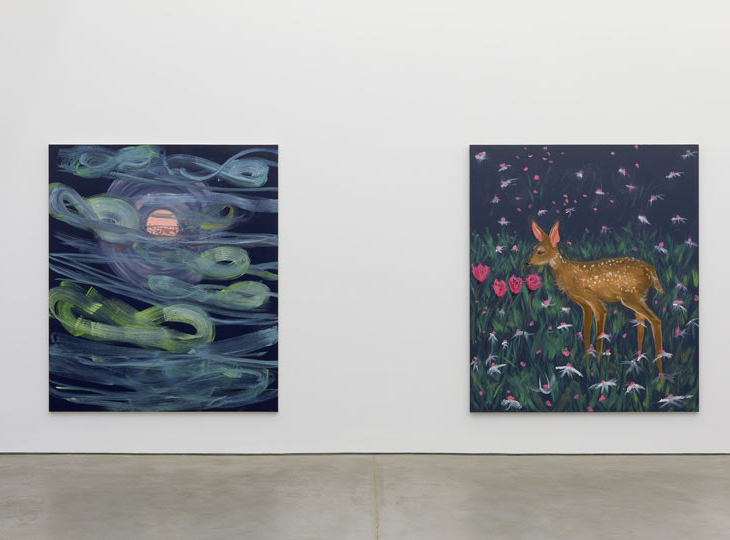
December 13, 2023
Download as PDF
View on The Brooklyn Rail
I wonder how often Ann Craven hears wolves howling at the moon. I wonder if she has ever tried to paint that sound. It seems like an unfair proposition for a painter, but Ann Craven paints the wind. She paints the wind, and she does it without recourse to secondary phenomena like bending branches and blossoms in flight. With brushstrokes that sweep across the canvas, Craven makes what can’t be seen into a visual occurrence, a physical, tactile picture of something no one’s ever held. It registers on the threshold between abstraction and representation.Craven is a great lover of the moon. She maintains a nocturnal practice of plein air painting and in her current show there is one outstanding example: Moon (Yellow Moon, Crazy 8’s, Again, 10-7-23), 2023 (all work 2023). She gives her audience three versions of the same composition: two oil paintings—one small, one large—and a watercolor. A peach orb glows from within a corona that centers the image upon the moon. Beneath it is a field of darkness. The moon seems to be laid down first, followed by Craven’s “Crazy 8’s”—her blowing wind. When Craven includes the date in the title, she links you into her ritual. She lets you know precisely when this moment occurred, and that mental note gives the painting surprising primacy. It’s not just “moon and wind,” it’s a particular moon, a particular wind. This is notable because Craven cuts the date from the title of the biggest canvas.
The exhibition is made of twenty-four works—three sets of eight paintings—spread across two locations. Because each composition is made thrice, the impulse to compare is irresistible. What changes from the watercolor to oil paint? From the small canvas to the large? It’s not as if one work is a study for another, though they obviously influence each other. What starts to come across as you ask yourself questions about scale and brushwork is that the true subject of Ann Craven’s paintings is not birds, moons, or deer. The subject is painting itself.
When I stand before the seven-foot-tall Fawn in Night Field, 2023, a very different response is elicited from my body from what occurs before the version that is twenty-four inches tall. One I seem to look at, the other I’m looking into. An odd and somewhat false sense of familiarity crops up seeing the same image in multiple iterations. But they are not the same and observing their distinctions is what enables the rich experience of attending to Craven’s astonishing mark-making. Consider the upward-swinging brush that gives rise to a green field and how that vertical momentum is balanced by daubs of pink paint that simultaneously establish depth and gravity. This painterly achievement occurs most explicitly at the largest scale.
Unlike her moon paintings, Craven’s bird compositions tend to be historically sourced and consequentially echo the work of others. Over the years the phrase “After Picabia” has shown up in a number of Craven’s titles. It does again in this exhibition:, Portrait of a Blue Bird (After Picabia, Black and White Light, Again, Again), 2023, and Portrait of a Blue Bird (Night Song, After Picabia), 2023. These are the titles of the large and small oil painting, but the watercolor stands apart: Blue Singing Finch (Night Song), 2023. If these were simply duplications of the same image, I’d expect the titles to log repetition. They don’t. As Craven paints the image, her experience of it changes. In this case, the “singing finch” becomes “a portrait” (of a blue bird) and its song is replaced with art historical referents. The titles tell a story of transformation. They show the crossing from a place of naturalism to one of aesthetics. What excites returning viewers is the impression that Craven knows this crossing well, that she’s trod the path enough times to take it confidently in the dark, and that repetition does not level out into predictability.



